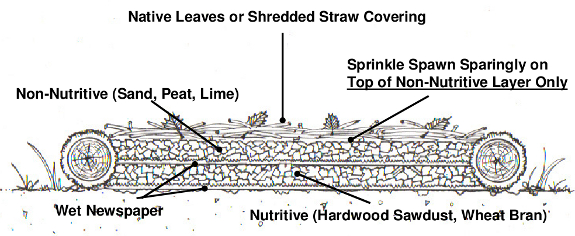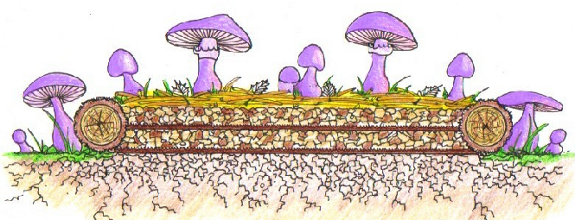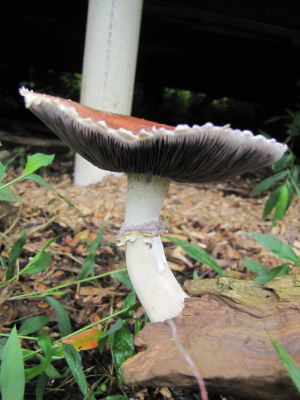
Morel and King Stropharia beds
In addition to
suggesting ways to make our mushroom log operation lower tech, Tradd
also had hints to create morel and king
stropharia beds that
actually work. I've dabbled in both of these species, but have
barely gotten any fruit, so my next attempt will use the much more
specific techniques advocated by Mushroom Mountain. (I stole the images
here from their website, where you can go for more information and to
buy spawn.)

Morels are one of the
toughest mushroom species to grow, but Tradd has a lot of luck when he
locates his beds in a damp, shady area near one of the trees morels
associate with (tulip-trees, ash, cottonwood, etc.) Make a 4 foot
by 4 foot by 8 inch bed by layering wet newspapers; a mixture of soaked
hardwood sawdust, wheat bran, and shredded leaves topped with one cup
of pelletized lime; another layer of wet newspaper; a mixture of peat
moss, sand, and lime with a pH of 7.5 to 8.0; 4 cups of spawn; then one
to two inches of leaves or wheat straw. Water the bed to keep it
moist for two months, then water once a month until winter hits.
If you've followed these instructions to the letter, you should collect
your homegrown morels in the spring.

 I'm a bit daunted by the
complexity of the morel bed, but I think that we can tweak our king
stropharia methodology and actually get a crop from this species.
The trick here seems to be using layers of cardboard to seal the
moisture into the bed. In a shady spot, put down a layer of wet
cardboard, then sprinkle on a bit of King Stropharia spawn. Add
three inches of hardwood chips or compost and mix in more spawn.
Lay down a sheet of wet cardboard or newspaper, punching or tearing
holes so that water will be able to pass through to the chips below,
then sprinkle on spawn and add three more inches of wood chips/spawn
mixture. Finally, mulch with straw or leaves. The tricky
part is remembering to water --- every day for a week, every other day
for the next three weeks, then once a month if you don't get rain.
I'm a bit daunted by the
complexity of the morel bed, but I think that we can tweak our king
stropharia methodology and actually get a crop from this species.
The trick here seems to be using layers of cardboard to seal the
moisture into the bed. In a shady spot, put down a layer of wet
cardboard, then sprinkle on a bit of King Stropharia spawn. Add
three inches of hardwood chips or compost and mix in more spawn.
Lay down a sheet of wet cardboard or newspaper, punching or tearing
holes so that water will be able to pass through to the chips below,
then sprinkle on spawn and add three more inches of wood chips/spawn
mixture. Finally, mulch with straw or leaves. The tricky
part is remembering to water --- every day for a week, every other day
for the next three weeks, then once a month if you don't get rain.
I have to admit that
just writing out these directions makes me lean toward focusing most of
our efforts on low-work oyster mushrooms. But it's never good to
put all of your eggs in one basket (and I like a challenge), so I might
try at least another king stropharia bed this year, if not a morel bed.
| This post is part of our Low Tech Mushroom Cultivation lunchtime
series.
Read all of the entries: |
Want more in-depth information? Browse through our books.
Or explore more posts by date or by subject.
About us: Anna Hess and Mark Hamilton spent over a decade living self-sufficiently in the mountains of Virginia before moving north to start over from scratch in the foothills of Ohio. They've experimented with permaculture, no-till gardening, trailersteading, home-based microbusinesses and much more, writing about their adventures in both blogs and books.
Want to be notified when new comments are posted on this page? Click on the RSS button after you add a comment to subscribe to the comment feed, or simply check the box beside "email replies to me" while writing your comment.
- Remove comment
